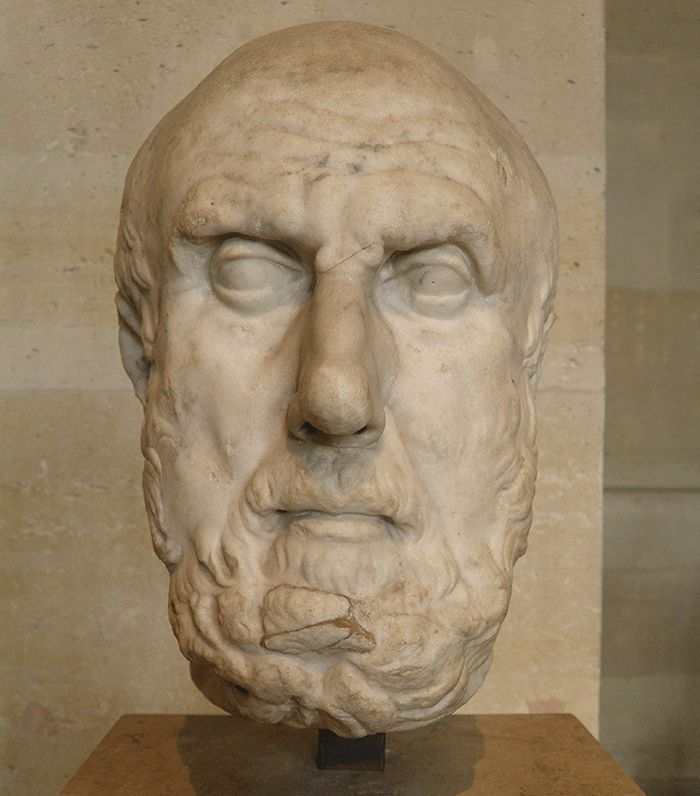 Figure: A bust of Chrysippus, 2nd century, Louvre Museum, Paris, France. Source: Wikimedia Commons.
Figure: A bust of Chrysippus, 2nd century, Louvre Museum, Paris, France. Source: Wikimedia Commons.
Despite being one of the most common operations worldwide, the origin of cataract surgery is unknown. Currently, the earliest known medical description of cataract extraction can be located in the seventh chapter of “De Medicine” written by Celsus in the second century CE (1). But when and where did the practice originate? In the search for answers, some have looked towards the ancient Egyptians, a civilization known for developing a large pool of knowledge in many fields. Though the Egyptians may be the progenitors of this technique, there is currently no direct evidence that they used cataract surgery – and so it remains just one hypothesis (2). As a result of the uncertainty surrounding the issue, legendary Indian physician Sushruta, who likely lived in the sixth century BCE, is often assumed to be the father of cataract surgery; however, if we’re looking for the first description, we have to accept that the earliest surviving manuscripts of Sushruta’s work, “Sushruta Samhita: Uttara Tantra,” actually date from the Common Era (3).
Instead, and interestingly so, the earliest available description of cataract surgery actually comes from philosophy rather than medicine. The description was written by Chrysippus, an Athenian philosopher who lived in the third century BCE, but this text was incompletely preserved (4). A fragment of Chrysippus’ work was later included by Simplicius from Cicilia in his commentary on Aristotle’s “Categories,” dating from the sixth century CE (see Figure 1). The fragment by Simplicius reads as such:
“[…] Aristotle solves such disputes too by adding another difference between them, namely that contraries can change round in the things capable of receiving them, but it is not possible that a change occurring from either possession or privation can cause the other one to come about. For although blindness comes about from sight, this change does not occur in the reverse direction as well. And because of this Chrysippus raised the question whether those suffering from a cataract but able to recover sight after a couching of the eye be called blind, and he also raised the same question in the case of those whose eyelids are naturally shut: for since the capacity to see exists, they resemble someone voluntarily keeping his eyes shut, or someone prevented by a screen from seeing, since if this screen is removed, he is in no way prevented from seeing. So it is not from privation to possession that such a change comes about. But Aristotle is here considering the kind of privation which consists in a disability. For from such a privation there is no return to the corresponding possession (5, 6).”
Ancient cataract surgery
So what did cataract surgery look like in the times of the ancient Greeks? The word used by Chrysippus to denote the cataract surgery itself – the verb “parakenteo” – means “to pierce or poke at the side,” indicating that this procedure required some form of stabbing, presumably using a sharp instrument (7). The precise location of this stabbing is unknown as “to the side” could refer to either the location of the stabbing or the act of stabbing from side to side. However, Simplicius adds further context in his commentary: he compares a cataract to a curtain that needs to be torn away or removed. Beyond this, further details are unknown.
It should be noted that the exact Chrysippus that Simplicius refers to has been up for debate, as several prominent figures of the period shared the same name (4). These include the philosopher Chrysippus of Soli, and Chrysippus of Cnidus, a physician who had both a son and a grandfather named Chrysippus, as well as a pupil, Erasistratos, who passed on the name to his son. Despite this, all evidence seems to point to Chrysippus of Soli being the likely candidate. The Athenian philosopher was born in 277 BC, and came from either Soli or Tarsus. He was a pupil of Cleanthes and, before that, practiced as a long-distance runner. After withdrawing from Cleanthes’ school, Chrysippus attained eminence as a philosopher, specializing in logic and, as was typical of Stoics, ethics. He died in 208 BC.
The fact that both Chrysippus and Simplicius used cataract surgery as an example within their respective philosophical texts suggests that the procedure was well known to Athenians, indicating that although we have not found earlier practitioners than Sushruta, the quest to find the origin of cataract surgery continues.
Acknowledgement
To conduct research into this topic, I invited professional philosopher (and privately my cousin), Juliusz Grzybowski, to help me. I would not have been able to complete it without him and I am very grateful for his help.
References
- Celsus, De Medicina, Vol 1-3, William Heineman and G. P. Putnamm’s Sons: 1961.
- P Blomstedt, J Cataract Refract Surg, 40, 485 (2014). PMID: 24485861.
- A Grzybowski, FJ Ascaso, Acta Ophthalmol, 92, 194 (2014). PMID: 23464869.
- J Grzybowski, A Grzybowski, Medicines (Basel), 7, 34 (2020). PMID: 32580363.
- Simplicius, In Aristotelis Categoria Commentarium, Vol 8, Reimer: 1907.
- Simplicius, On Aristotle Categories 9–15, Bloomsbury Academic: 2013.
- HG Liddell, R Scott, A Greek-English Lexicon, Clarendon Press: 1966.
